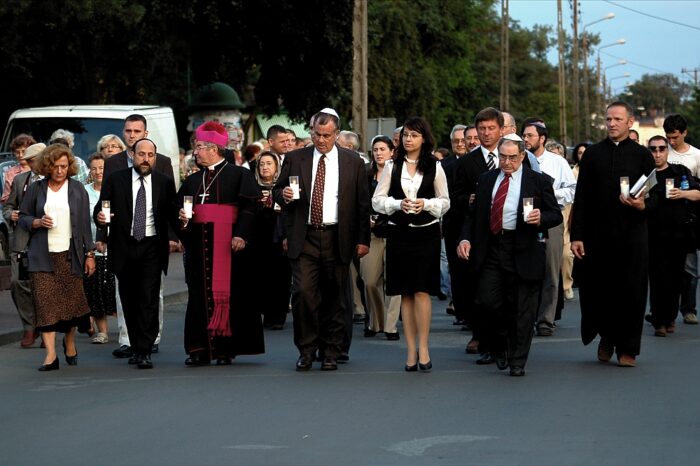
The memory remains. The Otwock synagogues are gone, and the Jews of Otwock are gone. As long as the memory remains, however, they too are present.
On a sweltering evening in the middle of summer vacation—August 19, 2007—several hundred people gathered at a railroad siding in Otwock. A banner above their heads reads: “No other day changed the history of Otwock so much.” Sixty-five years earlier to the day, in 1942, German occupation forces loaded some eight thousand Otwock Jews, half the population of the Warsaw suburb, on a train to the Treblinka death camp.
About 400 Jews returned to Otwock after the war. They oversaw the erection of a memorial stone at the site of mass executions. Soon, however, they were gone; they could not bear to look on the way their town had changed. For long years, some individual Otwock residents still remembered the Jews. Local history buffs gathered on occasion, but in miniscule numbers. Memories were fading—it was already possible to be born and grow up in Otwock without knowing anything about its Jewish past.
The turning point came in the spring of 2002, before the 60th anniversary of the annihilation of the Otwock ghetto. Four local residents—Father Wojciech Lemański, the parish priest; Zbigniew Nosowski, editor of “Więź”, a Catholic monthly review in Warsaw; and history teacher Maria Bołtryk and Polish teacher Katarzyna Kałuszko from the high school—published an announcement in the local newspaper headlined “Remember for the Future.” Instead of going on feeling bad about having done so little to remember their Jewish fellow citizens, they decided to found a Citizens’ Committee for the Remembrance of the Jews of Otwock and Karczew, and to go to work.
Since then, the Committee has held many events. The best known is the annual march of remembrance and prayer, held on August 19, the anniversary date. German perpetrators called tehir action “liquidation of the ghetto”, but we prefer to speak about annihilation of the Jews of Otwock, says Nosowski. The local government always lends its active support. The march sets out from the railroad siding and ends at the memorial stone, where Jews and Christians join to pray the Psalms and say the Kaddish and John Paul II’s prayer for the Jewish people.
Jewish former residents of Otwock and their descendants attend each year. There are also officially invited guests. In 2007, on the 65th anniversary, they included Minister Ewa Junczyk-Ziomecka from the chancellery of the President of Poland, Ambassador David Peleg of Israel, Metropolitan Sławoj Leszek Głódź of the Warsaw-Praga Diocese, and the chief rabbi of Poland, Michael Schudrich.
Work has also been underway since 2002 to improve the condition of the local Jewish cemetery. Committee members point out that their work is also a form of compensation for vandalism committed since the war by other Otwock residents.
The appearance of the cemetery, located in the woods, has changed markedly. A few years ago, the gravestones were completely hidden by dense undergrowth. Today, the bushes have been trimmed, dried-out tree trunks removed, and the grounds surrounded with fieldstones. Polish and American volunteers, Catholics and Baptists, worked at putting a total of some 80 tons of stones in place.
The committee has also organized numerous lectures, educational sessions, and cultural events, addressed mostly to young people, in the belief that the future depends on them.
Today, thanks to the work by the teachers, Jewish youth groups, including participants in the March of the Living, stop willingly in Otwock during visits to Poland. In recent years, students at Otwock schools have met repeatedly with their Jewish peers from Australia, the USA, and Israel. They join in the work at the cemetery, and there is time for discussions and relaxation afterwards.
Committee members have played a role in publishing important books on Otwock’s Jewish past. Several times in recent years, the Committee has also helped organize ceremonies where local residents who risked their lives to rescue their Jewish neighbors received Righteous among the Nations of the World medals. In an exceptional ceremony, the Sisters of St. Elizabeth, who ran an orphanage in Otwock during the war, received a medal for sheltering Jewish children.
Isaac Bashevis Singer, who won the Nobel Prize for literature, was one of many who wrote about Otwock: “At a distance of a dozen or more kilometers from Warsaw lies the little town of Otwock. It was famed throughout Poland for its crystalline air and its sanatoria for people suffering from lung disease. … Thousands of families came to Otwock and the nearby localities in the summer. … It is hard to imagine that there are no Jews there anymore. Nothing remains but the sand on which we built…”
Today, the members of the Otwock Committee point out proudly on their website that the great writer was in error: “Much more remains of the Otwock Jews than only the sand. The memory remains. True, the Otwock synagogues are gone, and the Jews of Otwock are gone. As long as the memory remains, however, they too are present.”
Katarzyna Jabłońska
Translated by William Brand
Part of the book “The Bond of Memory. Polish Christians in Dialogue with Jews and Judaism” published in 2008 by the Więź Laboratory. The book may be dowloaded here.